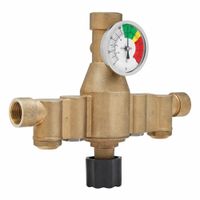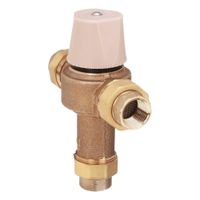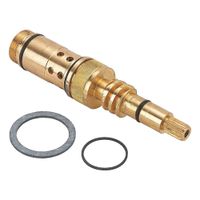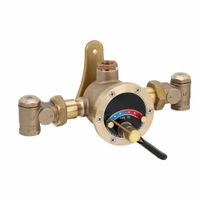Call +(254) 703 030 000 / 751 483 999 / 721 704 777
- Home
- Plumbing
- Plumbing Valves
- Pressure Temperature Control Valves
- Mixing Valves
Mixing Valves
Mixing valves are devices that blend multiple streams of fluid at varying temperatures to produce a desired output temperature. Hot and cold water mixing valves maintain a safe and consistent water temperature for washing and showering. Steam and cold water mixing valves are used in commercial and i .....Read More
Frequently Asked Questions
What is a mixing valve and how does it work?
A mixing valve is a device used to blend hot and cold water to achieve a desired temperature output. It is commonly used in plumbing systems to ensure consistent water temperature for various applications, such as showers, faucets, and heating systems.
The mixing valve operates by using a thermostatic element or a mechanical mechanism to control the flow of hot and cold water. It typically consists of an inlet for hot water, an inlet for cold water, and an outlet for the mixed water. Inside the valve, a temperature-sensitive element, such as a wax or liquid-filled capsule, expands or contracts in response to temperature changes. This movement adjusts the internal mechanism, which regulates the proportion of hot and cold water entering the valve.
When the desired temperature is set, the mixing valve maintains it by automatically adjusting the flow rates of hot and cold water. If the incoming water temperature or pressure changes, the valve compensates by altering the mix to keep the output temperature constant. This ensures user safety by preventing scalding from excessively hot water and discomfort from water that is too cold.
Mixing valves are essential in systems where precise temperature control is crucial, such as in healthcare facilities, hotels, and residential homes. They enhance comfort, safety, and energy efficiency by reducing the need for manual temperature adjustments and minimizing water wastage.
How do you adjust a mixing valve for a shower?
1. **Turn Off Water Supply**: Shut off the water supply to the shower to prevent any leaks or water flow during the adjustment process.
2. **Remove Handle and Trim**: Use a screwdriver to remove the shower handle and any trim plate covering the valve. This will expose the mixing valve.
3. **Locate the Adjustment Mechanism**: Identify the adjustment mechanism on the mixing valve. This is often a plastic or metal piece that can be turned or adjusted with a screwdriver or wrench.
4. **Adjust Temperature Limit Stop**: If the valve has a temperature limit stop, adjust it to control the maximum hot water temperature. Turn it clockwise to decrease the temperature and counterclockwise to increase it.
5. **Test Water Temperature**: Turn the water supply back on and test the shower water temperature. Allow the water to run for a few minutes to reach a stable temperature.
6. **Fine-Tune Adjustment**: If the temperature is not satisfactory, turn off the water supply again and make further adjustments to the mixing valve. Repeat the testing process until the desired temperature is achieved.
7. **Reassemble the Shower Handle and Trim**: Once the temperature is set to your satisfaction, reattach the trim plate and shower handle securely.
8. **Check for Leaks**: Turn the water supply back on and check for any leaks around the valve or handle. Tighten any loose components if necessary.
9. **Final Test**: Conduct a final test of the shower to ensure the temperature is consistent and the valve is functioning properly.
10. **Safety Check**: Ensure the maximum temperature is safe to prevent scalding, especially if children or elderly individuals will be using the shower.
What are the signs of a faulty mixing valve?
Signs of a faulty mixing valve include:
1. **Inconsistent Water Temperature**: Fluctuations in water temperature, such as sudden changes from hot to cold or vice versa, indicate a malfunctioning mixing valve.
2. **No Hot Water**: If the mixing valve fails, it may prevent hot water from reaching the faucet, resulting in only cold water being dispensed.
3. **Scalding Water**: A faulty valve might not regulate the temperature properly, leading to excessively hot water that can cause scalding.
4. **Reduced Water Pressure**: A malfunctioning valve can restrict water flow, leading to lower water pressure at the tap.
5. **Leaking**: Visible leaks around the valve or dripping water can be a sign of internal damage or wear.
6. **Unusual Noises**: Whistling, banging, or other unusual noises when the water is running can indicate a problem with the valve.
7. **Corrosion or Mineral Buildup**: Visible corrosion or mineral deposits on the valve can impair its function and lead to failure.
8. **Difficulty in Adjusting Temperature**: If the valve is hard to turn or does not respond to adjustments, it may be faulty.
9. **Water Hammer**: A faulty valve can cause a water hammer effect, characterized by loud banging noises in the pipes when the water is turned on or off.
10. **Frequent Repairs**: If the valve requires frequent maintenance or repairs, it may be time to replace it.
11. **Age of the Valve**: Older valves are more prone to failure due to wear and tear over time.
12. **Visible Damage**: Cracks or other visible damage to the valve body can indicate a need for replacement.
How do you replace a mixing valve?
1. **Turn Off Water Supply**: Shut off the main water supply to prevent any leaks or water flow during the replacement process.
2. **Drain the System**: Open the faucets to drain any remaining water in the pipes.
3. **Access the Mixing Valve**: Remove any coverings or panels to access the mixing valve. This may involve unscrewing or unclipping parts of the shower or sink.
4. **Disconnect the Old Valve**: Use a wrench to loosen and remove the nuts or screws holding the mixing valve in place. Carefully disconnect the valve from the water supply lines.
5. **Remove the Old Valve**: Take out the old mixing valve from its position. Ensure that all components, such as washers or seals, are also removed.
6. **Prepare the New Valve**: Check the new mixing valve for any defects. Apply plumber’s tape to the threads of the new valve to ensure a tight seal.
7. **Install the New Valve**: Position the new mixing valve in place. Connect it to the water supply lines, ensuring that the hot and cold lines are correctly aligned. Tighten the nuts or screws securely.
8. **Check for Leaks**: Turn the water supply back on and check for any leaks around the new valve. Tighten connections if necessary.
9. **Test the Valve**: Turn on the faucet or shower to test the new mixing valve. Ensure that it properly mixes hot and cold water and that the temperature is adjustable.
10. **Reassemble and Clean Up**: Replace any coverings or panels that were removed. Clean up the work area and ensure all tools are put away.
11. **Final Inspection**: Double-check all connections and ensure everything is functioning correctly.
What is the difference between a thermostatic mixing valve and a pressure balancing valve?
A thermostatic mixing valve (TMV) and a pressure balancing valve are both used in plumbing systems to regulate water temperature and prevent scalding, but they operate differently.
A thermostatic mixing valve automatically blends hot and cold water to maintain a constant, pre-set temperature, even if there are fluctuations in water pressure or temperature in the supply lines. It uses a thermostatic element that expands or contracts in response to temperature changes, adjusting the mix of hot and cold water accordingly. TMVs are highly precise and are ideal for applications where consistent water temperature is critical, such as in healthcare facilities or homes with young children or elderly individuals.
In contrast, a pressure balancing valve, also known as a mechanical or anti-scald valve, maintains a consistent water temperature by adjusting the flow of hot and cold water based on changes in water pressure. It uses a piston or diaphragm mechanism that responds to pressure differences between the hot and cold water supplies. If there is a sudden drop in pressure in one line (e.g., someone flushes a toilet), the valve adjusts the flow to maintain the balance, preventing sudden temperature spikes. However, it does not compensate for changes in water temperature, only pressure.
In summary, the key difference lies in their operation: TMVs control temperature directly and precisely, while pressure balancing valves adjust flow to maintain temperature indirectly by balancing pressure. TMVs are generally more effective in providing consistent temperature control, while pressure balancing valves are simpler and more cost-effective for basic anti-scald protection.
How do you maintain a mixing valve?
To maintain a mixing valve, follow these steps:
1. **Regular Inspection**: Periodically check for leaks, corrosion, or any visible damage. Ensure the valve is securely attached and there are no loose connections.
2. **Cleaning**: Turn off the water supply and disassemble the valve according to the manufacturer's instructions. Clean the internal components, such as the cartridge and filters, using a soft brush and a mild cleaning solution to remove mineral deposits and debris.
3. **Lubrication**: Apply a suitable lubricant to the moving parts of the valve to ensure smooth operation. Use a lubricant recommended by the manufacturer to avoid damage.
4. **Check Temperature Settings**: Verify that the temperature settings are accurate. Adjust the temperature control knob or lever to ensure it delivers the desired water temperature.
5. **Replace Worn Parts**: Inspect the O-rings, seals, and washers for wear and tear. Replace any damaged or worn parts to prevent leaks and ensure proper functioning.
6. **Reassemble and Test**: Carefully reassemble the valve, ensuring all components are correctly aligned and tightened. Turn the water supply back on and test the valve for leaks and proper temperature control.
7. **Professional Servicing**: Schedule regular professional maintenance, especially for complex systems or if you notice persistent issues. A professional can perform a thorough inspection and service.
8. **Documentation**: Keep a record of maintenance activities, including dates and any parts replaced, to track the valve's condition over time.
By following these steps, you can ensure the longevity and efficient performance of your mixing valve.
What are the benefits of using a mixing valve in plumbing systems?
A mixing valve in plumbing systems offers several benefits:
1. **Temperature Control**: Mixing valves blend hot and cold water to deliver water at a consistent, desired temperature, enhancing comfort and safety.
2. **Scald Prevention**: By regulating water temperature, mixing valves prevent scalding, especially important in homes with children or elderly individuals.
3. **Energy Efficiency**: They allow for lower water heater settings, reducing energy consumption and costs while maintaining adequate hot water supply.
4. **Water Conservation**: Mixing valves can reduce water wastage by delivering water at the right temperature more quickly, minimizing the time spent adjusting taps.
5. **System Protection**: They help protect plumbing systems from thermal shock and stress, extending the lifespan of pipes and fixtures.
6. **Compliance with Regulations**: Many building codes require mixing valves to ensure safe water temperatures, making them essential for compliance.
7. **Versatility**: Available in various types, such as thermostatic and pressure-balancing, they can be tailored to specific needs and applications.
8. **Improved Comfort**: Consistent water temperature enhances user comfort during showers and other water uses.
9. **Reduced Maintenance**: By preventing extreme temperatures, mixing valves can reduce wear and tear on plumbing components, lowering maintenance needs.
10. **Safety in Commercial Settings**: In commercial and institutional settings, they ensure safe water temperatures for multiple users, reducing liability risks.
Overall, mixing valves are a crucial component in modern plumbing systems, offering safety, efficiency, and comfort.



